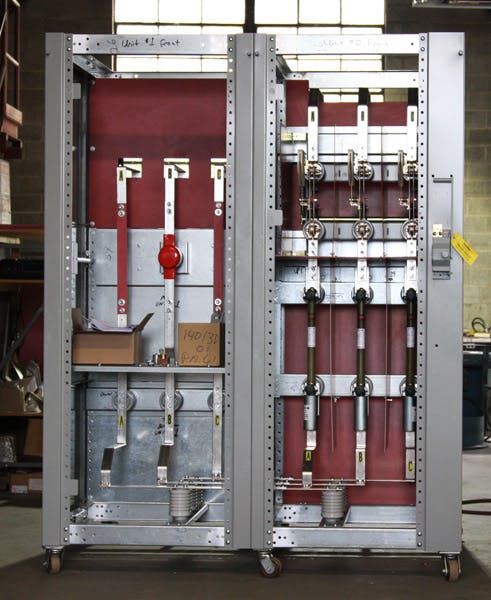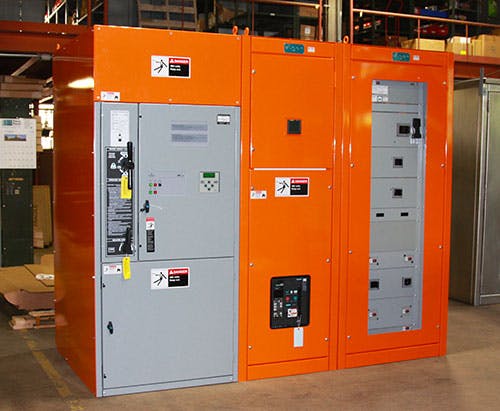Metal enclosed and metal clad are two different types of switchgear. However, it is more appropriate to say that metal clad is actually a specific subset of metal enclosed — much like a square is a specific subset of rectangle. Because these two types of switchgear are so similar, it can sometimes be difficult to tell the difference between them. The available fault currents, safety aspects, and how maintenance affects the systems are all different. And these pieces of information are exactly the kind you will need to know in order to determine which type is best for your particular situation.
Why Does Switchgear Matter?
If you are a seasoned veteran of electrical switchgear, you probably already know the importance of the right switchgear application. However, for those who are not aware, switchgear:
- Provides protection to electrical appliances by interrupting overloaded circuits,
- Isolates the “live” portions of the system to protect operators, and
- Controls the sources used to feed a load within the system.
Metal Enclosed Definition

Metal enclosed switchgear is fairly self-explanatory. This is switchgear which is enclosed in a metal shell. There is metal on all sides of the internal components, with the exception of small ventilation and viewport openings. Further, the outer shell is grounded to improve the safety of the system overall.
Within the scope of metal enclosed there are three subcategories, one of which is metal clad. The other two are low voltage power circuit breakers (IEEE C37.20.1) and metal enclosed interrupters (IEEE C37.20.3). Metal enclosed interrupters (MEIs) are essentially simplified construction versions of metal clad switchgear.
In the two switchgear types referred to as metal enclosed, there are minimal or no barriers between internal sections. Once the panel is opened, all of the components are there in one place. This fact helps drive the price down when compared to metal clad options.
Metal Clad Definition
Since metal clad switchgear (IEEE C37.20.2) is technically a subset of metal enclosed, it shares many of the same external properties. It is enclosed in a metal shell on all sides, with the exception of small ventilation and viewport openings. Again, the entire shell is grounded as well, but that is where the similarities end.
What sets metal clad apart from metal enclosed is that all of the internal components are also individually clad in metal, or compartmentalized. Each of these components may also be insulated, as in the case of bus bars, and grounded individually. And, the different compartments can be removed individually as well with minimal effect on the overall system, which is a major bonus. All of these upgrades add to the higher cost of metal clad when compared to metal enclosed.
Available Fault Current

Metal enclosed can be used for systems with smaller loads and a lower fault current. As the name implies, low voltage power circuit breakers are ideal for these low-fault currents. However, metal enclosed interrupters are medium voltage (2400V to 38kV) equipment that can be appropriate on simpler systems where a switch and fuse can provide adequate protection for a transformer.
Metal clad is for systems that have a higher available fault current. The circuit breakers used in metal clad switchgear can allow greater coordination within the electrical system.
Safety Aspects
In cases where there is a higher available fault current, metal clad switchgear can offer additional safety features. Because all of the internal components are compartmentalized, operators can gain access to each one individually. This means avoiding some of the more dangerous components while working on the less dangerous ones. Additionally, portions of the system can be turned on or off remotely, further reducing the likelihood of operator injury.
Finally, if one part of the system fails, the other parts are protected due to the compartmentalization. In an “open” system such as metal enclosed, when one part of the system fails, it can quickly get out of hand as other parts are affected by the initial failure. This is not the case in metal clad.
Switchgear Maintenance

The maintenance for metal enclosed switchgear can be easier than for metal clad due to all of the components being “out in the open.” When the panel is opened, everything is right there, ready to be maintained. This results in generally quicker maintenance. However, the downside is that there is more overall downtime because the various parts of the system are interconnected.
Metal clad switchgear is effectively the opposite. It can be easier in that the entire system does not need to be shut down when only one component is being maintained. But, while there is less downtime, it also means that the maintenance itself generally takes longer. In this respect, the pros and cons of each type of switchgear are effectively equal.
Metal Clad and Automatic Transfer Systems
In the event of a power outage, metal clad systems allow automatic transfer systems to have greater control. They can be programmed to automatically seek for live utility lines to which loads can be transferred. Additionally, sending signals to alternate power sources when needed, such as starting and synchronizing multiple generators, is another key task of such transfer systems.
Conclusion
When selecting which type of switchgear is ideal for your particular application you should consider these four aspects: the total connected load, selective coordination requirements, safety requirements, and potential maintenance. For higher loads, and increased safety, metal clad may be the best option. However, metal enclosed often costs less, and may be a better choice for lower loads.
There is also the option of a hybrid approach. With a hybrid system we combine a metal clad main circuit breaker with metal enclosed feeder switches.
Penn Panel & Box Company Custom Switchgear
At Penn Panel & Box Company we can build custom metal enclosed, metal clad, or hybrid switchgear depending on your specific application. And if you are not sure which option would be best for your application, we can help with that too. Our team of experts can help determine which kind of switchgear is right for you. And once the type of switchgear is determined, we will get to work designing and building a custom solution to fit your needs. Contact Penn Panel & Box Company today for more information about our custom switchgear.
